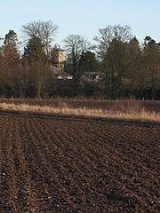
Huntingtower and Ruthvenfield
Encyclopedia

Perthshire
Perthshire, officially the County of Perth , is a registration county in central Scotland. It extends from Strathmore in the east, to the Pass of Drumochter in the north, Rannoch Moor and Ben Lui in the west, and Aberfoyle in the south...
, Scotland
Scotland
Scotland is a country that is part of the United Kingdom. Occupying the northern third of the island of Great Britain, it shares a border with England to the south and is bounded by the North Sea to the east, the Atlantic Ocean to the north and west, and the North Channel and Irish Sea to the...
, on the Almond, 3 miles northwest of Perth
Perth, Scotland
Perth is a town and former city and royal burgh in central Scotland. Located on the banks of the River Tay, it is the administrative centre of Perth and Kinross council area and the historic county town of Perthshire...
, and within 1 mile of Almondbank station on the Caledonian railway. Pop. (1901) 459.
Bleaching, the chief industry, dates from 1774, when the bleaching-field was formed. By means of an old aqueduct
Aqueduct
An aqueduct is a water supply or navigable channel constructed to convey water. In modern engineering, the term is used for any system of pipes, ditches, canals, tunnels, and other structures used for this purpose....
, said to have been built by the Romans, it was provided with water from the Almond, the properties of which render it specially suited for bleaching.
Huntingtower (originally Ruthven) Castle
Huntingtower Castle
Huntingtower Castle once known as Ruthven Castle or the Place [Palace] of Ruthven is located near the village of Huntingtower beside the A85 and near the A9, about 5km NW of the centre of Perth, Perth and Kinross, in central Scotland, on the main road to Crieff.- History :Huntingtower Castle was...
, a once formidable structure, was the scene of the Raid of Ruthven
Raid of Ruthven
The Raid of Ruthven was a political conspiracy in Scotland which took place on 22 August 1582. It was composed of several Presbyterian nobles, led by William Ruthven, 1st Earl of Gowrie, who abducted King James VI of Scotland. He was seized while staying at the castle of Ruthven , and kept under...
(pron. Rivven), when the Protestant lords, headed by William, 4th Lord Ruthven and 1st earl of Gowrie
Earl of Gowrie
Earl of Gowrie is a title that has been created twice, once in the Peerage of Scotland and once in the Peerage of the United Kingdom, both times for members of the Ruthven family. It takes its name from Gowrie, a historical region and ancient province of Scotland. On 23 August 1581 William Ruthven,...
(1441–1584), kidnapped the boy-king James VI, on August 22, 1582. The earl's sons were slain in the attempt (known as the Gowrie conspiracy) to capture James VI (1600), consequent on which the Scots parliament ordered the name of Ruthven to be abolished, and the barony to be known in future as Huntingtower.
Notable persons
George TurnbullGeorge Turnbull (civil engineer)
George Turnbull was the Chief Engineer responsible for construction from 1851 to 1863 of the first railway line from Calcutta : the 541-mile line to Benares en route to Delhi...
was brought up in Huntingtower. He was the Chief Engineer building the first major Indian railway in the 1850s.
----

